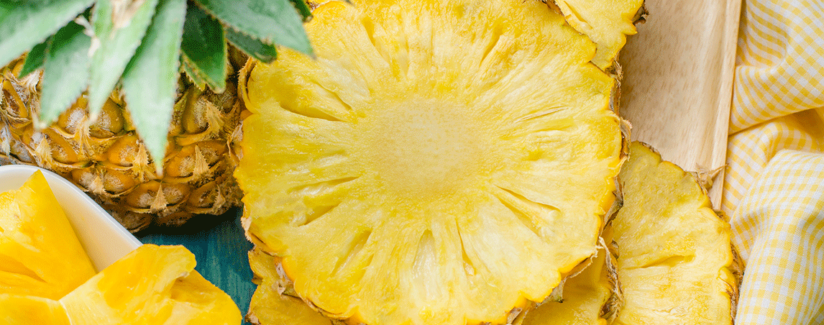
Say Aloha to Delicious, Nutritious Pineapple
Pineapple is one of those wonderful foods that both tastes delicious and is good for you. As we set out to learn more about pineapple nutrition, we discovered that expert Anne Elizabeth Cundiff, RD, LD, FAND lived in Hawaii as a child.
“One of my favorite memories was taking our friends and family to pick their own pineapples at the farms we lived by,” she said.
“Fresh pineapple is my favorite way to enjoy pineapple,” she added. “It is also the perfect fruit to grill because it will caramelize nicely. Grill slices of pineapple or place pineapple chunks on kabobs with your favorite protein and vegetables. The pineapple juice naturally tenderizes the meat and vegetables.”
Pineapple’s sweet and tart flavor is very versatile, enjoyed in meat dishes, pizza, salad, dessert and drinks. The fruit is loaded with nutrients.
“The main nutrients found in pineapple are energy-producing carbohydrates, the immune-boosting Vitamin C and the trace mineral manganese that helps our bodies form bones and connective tissue,” Cundiff said. “Pineapple also has the red blood cell producing mineral copper and other B vitamins such as folate, which is important for normal cell function and tissue growth.”
Pineapple also contains bromelain, an enzyme that digests protein that is only found in pineapple, she explained. That’s why pineapple is often used to tenderize meats before cooking. The enzyme is highly concentrated in the stem and is found in lower concentration in the fruit. Bromelain is being studied for other benefits it may provide.
“There are various studies focusing on the high-concentration bromelain found and extracted from the stem and its role in health. Bromelain may reduce inflammation and decrease joint pain and arthritis, aid in wound healing, and minimize the severity of angina (chest pain caused by reduced blood flow to the heart),” Cundiff said.
Bromelain also has another effect. It’s related to a question we received from a reader on an article about a genetically engineered pink pineapple: “My tongue always hurts a little bit when I eat regular pineapple…do developers know if the new pink pineapple will still have that same characteristic?”
“The enzyme bromelain found in pineapple may cause the irritation and a slight burning sensation in your mouth when consuming it in the fresh state. If you would like to decrease the sensation, make sure to cut the core out of the pineapple because of the higher concentration of bromelain in the stem. Heating the fruit (grilling, baking) will decrease the concentration of enzymes,” Cundiff said. “The producer of the pink pineapple, Del Monte Fresh Produce, claims the pineapple will produce lower levels of the bromelain enzyme.”
There are numerous claims about pineapple benefits for health. We wanted to know if there was any science to support these claims. Cundiff explained that almost all fruits and vegetables are great sources of a variety of vitamins, minerals and phytochemicals that play a role in preventing disease. For instance, progression of macular degeneration, which results in vision loss, may be delayed by consuming foods rich in beta-carotene, like pineapple.
“Pineapple also has fiber, which may decrease episodes of diarrhea, constipation and may decrease hunger because of the satiety properties of fiber,” Cundiff said. She offered this tip to evaluate if a statement is valid. “Most articles making health claims about pineapple are usually referring to the health benefits of a particular vitamin or mineral found in a variety of other fruits and vegetables.”
The way pineapple is prepared makes a difference in the amount of calories and sugar. This chart compares one cup of fresh or frozen, canned and pineapple juice.
“As a registered dietitian, I always advise monitoring sugar intake over the course of a day and I recommend focusing on portion size. I recommend two to three servings of fruit a day which a serving translates to 1 cup of fresh or frozen, ½ cup of canned, ¼ cup of dried fruit or 4 ounces of 100% juice,” Cundiff said.
For a special treat, Cundiff shared her family favorite recipe of Baked Aloha. “Our family enjoys it on baked ham and pork loin.”
Anne Cundiff’s Baked Aloha
Serving size: 2 Tablespoons. Makes around 2 cups
1 20-ounce can crushed pineapple, drained
¼ cup cold water
2 eggs, beaten
2 tablespoons cornstarch
½ cup sugar
1 teaspoon vanilla
¼ teaspoon cinnamon
1 tablespoon butter, cut into small pieces
- Heat oven to 325 degrees.
- In a large bowl, combine pineapple, water, eggs, cornstarch, sugar and vanilla.
- Pour mixture into an ungreased 1-½ quart casserole dish. Sprinkle cinnamon over the top and dot with butter.
- Bake uncovered for 1 hour or until thickened and slightly browned on top.
The delicious and nutritious benefits of pineapple can be enjoyed many ways.



























